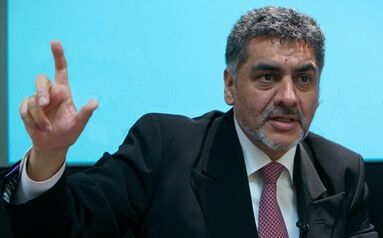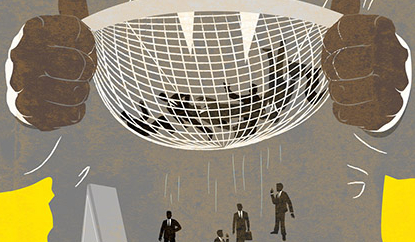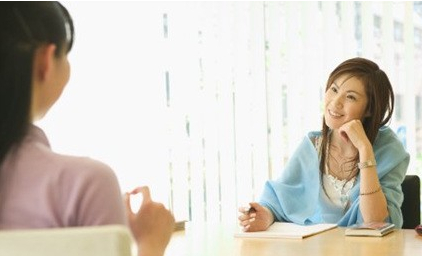中华人民共和国专利法实施细则(二)
|
Rule 35. Two or more inventions or utility models belonging to a single general inventive concept which may be filed as one application in accordance with the provision of Article 31, paragraph one, of the Patent Law shall be technically inter-related and contain one or more same or corresponding special technical features. The expression “special technical features” shall mean those technical features that define a contribution which each of those inventions, considered as a whole, makes over the prior art. The claims in one application for a patent for two or more inventions which are in conformity with the provisions of the preceding paragraph may be any of the following: (1) independent claims of the same category for two or more products or processes which cannot be included in one claim; (2) an independent claim for a product and an independent claim for a process specially adapted for the manufacture of the product; (3) an independent claim for a product and an independent claim for a use of the product; (4) an independent claim for a product, an independent claim for a process specially adapted for the manufacture of the product, and an independent claim for a use of the product; (5) an independent claim for a product, an independent claim for a process specially adapted for the manufacture of the product, an independent claim for an apparatus specially designed for carrying out the process; (6) an independent claim for a process and an independent claim for an apparatus specially designed for carrying out the process. The claims in one application for a patent for two or more utility models which are in conformity with the provisions of the first paragraph may be independent claims for two or more products which cannot be included in one claim. Rule 36. The expression “the same class” mentioned in Article 31, paragraph two of the Patent law means that the products incorporating the designs belong to the same subclass in the classification of products for designs. The expression “be sold or used in sets” means that the products incorporating the designs have the same designing concept and are customarily sold or used at the same time. Where two or more designs are filed as one application in accordance with the provisions of Article 31, paragraph two, of the Patent Law, they shall be numbered consecutively and the numbers shall be placed in front of the titles of the view of the product incorporating the design. Rule 37. When withdrawing an application for a patent, the applicant shall submit to the Patent Office a declaration stating the title of the invention- creation, the filing number and the date of filing. Where a declaration to withdraw an application for a patent is submitted after the printing preparation has been done by the Patent Office for publication of the application documents, the application shall be published as scheduled. Chapter III EXAMINATION AND APPROVAL OF APPLICATION FOR PATENT Rule 38. In any of the following situations, any person who makes examination or hears a case in the procedures of preliminary examination, examination as to substance, reexamination, revocation and invalidation shall, on his own initiative or upon the request of the parties concerned or any other interested person, be excluded from exercising his function: (1) where he is a close relative of the party concerned or his agent; (2) where he has an interest in the application for patent or the patent right; (3) where he has such other kinds of relations with the party concerned or his agent that might influence impartial examination and hearing. Where a member of the Patent Reexamination Board has taken part in the examination of the application, the provisions of the preceding paragraph shall apply. The exclusion of persons making examination and hearing cases shall be decided by the Patent Office. Rule 39. Upon the receipt of an application for a patent for invention or utility model consisting of a request, a description (a drawing being indispensable for utility model) and one or more claims, or an application for a patent for design consisting of a request and one or more drawings or photographs showing the design, the Patent Office shall accord the date of filing and a filing number and notify the applicant. Rule 40. In any of the following situations, the Patent Office shall declare the application unacceptable and notify the applicant accordingly; (1) where the application for a patent for invention or utility model does not contain a request, a description (the description of utility model does not contain drawings) or claims, or the application for a patent for design does not contain a request, drawings or photographs; (2) where the application is not written in Chinese; (3) where the application is not in conformity with the provisions of Rule 94, paragraph one, of these Implementing Regulations; (4) where the request does not contain the name and address of the applicant; (5) where the application is obviously not in conformity with the provisions of Article 18, or Article 19, paragraph one, of the Patent Law; (6) where the kind of protection (patent for invention, utility model or design) of the application for a patent is not clear and definite or cannot be discerned. Rule 41. Where the description mentions that it contains “explanatory notes to the drawings” but the drawings or part of them are missing, the applicant shall, within the time limit specified by the Patent Office, either furnish the drawings or make a declaration for the deletion of the “explanatory notes to the drawings”。 If the drawings are submitted later, the date of their delivering at, or mailing to, the Patent Office shall be the date of filing of the application; if the mention of “explanatory notes to the drawings” is to be deleted, the initial date of filing shall be the date of filing of the application. Rule 42. Where an application for a patent contains two or more inventions, utility models or designs, the applicant may, at any time before the Patent Office sends out the notification to grant the patent right, submit to the Patent Office a divisional application. If the Patent Office finds that an application for a patent is not in conformity with the provisions of Article 31 of the Patent Law and Rule 35 of these Implementing Regulations, it shall invite the applicant to amend the application within the specified time limit; if the applicant does not make any response within the time limit, the application shall be deemed to have been withdrawn. The divisional application may not change the kind of protection of the initial application. Rule 43. A divisional application filed in accordance with Rule 42 of these Implementing Regulations may enjoy the date of filing and, if priority is validly claimed, the priority date of the initial application, provided that the divisional application does not go beyond the scope of disclosure contained in the initial application. The divisional application shall be subject to the procedures in accordance with the provisions of the Patent Law and these Implementing Regulations. The filing number and the date of filing of the initial application shall be indicated in the request of a divisional application. When submitting the divisional application, the applicant shall submit a copy of the initial application document; if priority is claimed for the initial application, the applicant shall submit a copy of the priority document of the initial application as well. Rule 44. “Preliminary examination” mentioned in Articles 34 and 40 of the Patent Law means examining an application for a patent to see whether or not it contains the documents as provided for in Articles 26 or 27 of the Patent Law and other necessary documents, and whether or not those documents are in the prescribed form; such examination shall also include the following: (1) whether or not an application for a patent for invention obviously falls under Articles 5 or 25 of the Patent Law, or is obviously not in conformity with the provisions of Article 18 or Article 19, paragraph one, or is obviously not in conformity with the provisions of Article 31, paragraph one, or Article 33 of the Patent Law, or Rule 2, paragraph one, of these Implementing Regulations; (2) whether or not an application for a patent for utility model obviously falls under Articles 5 or 25 of the Patent Law, or is obviously not in conformity with the provisions of Article 18 or Article 19, paragraph one, or is obviously not in conformity with the provisions of Article 31, paragraph 1, or Article 33 of the patent Law, or Rule 2, paragraph two, or Rule 12, paragraph one, or Rules 18 to 23 of these Implementing Regulations, or cannot obtain a patent right according to the provisions of Article 9 of the Patent Law; (3) whether or not an application for a patent for design obviously falls under Article 5 of the Patent Law, or is obviously not in conformity with the provisions of Article 18 or Article 19, paragraph one, or is obviously not in conformity with the provisions of Article 31, paragraph two, or Article 33 of the Patent Law, or Rule 2, paragraph three, or Rule 12, paragraph one, of these Implementing Regulations, or cannot obtain a patent right according to the provisions of Article 9 of the Patent Law. The Patent Office shall communicate its observations after examination of the application to the applicant and invite him or it to submit his or its observations or to correct his or its application within the time limit. If the applicant makes no response within the time limit, the application shall be deemed to have been withdrawn. Where, after the applicant has made the observations or the corrections, the Patent Office still finds that the application is not in conformity with the provisions of the Articles and the Rules cited in the relevant preceding sub-paragraph, the application shall be rejected. Rule 45. In any of the following situations, any document relating to a patent application, not including the patent application, which is submitted to the Patent Office, shall be deemed not to have been submitted: (1) where the document is not presented in the prescribed form or the indications therein are not in conformity with the prescriptions; (2) where no supporting document is submitted as prescribed. The applicant shall be notified that the document is deemed not to have been submitted. Rule 46. Where the applicant requests an earlier publication of its or his application for a patent for invention, a declaration shall be made to the Patent Office. The Patent Office shall, after preliminary examination of the application and, unless it is to be rejected, publish it immediately. Rule 47. The applicant shall, when indicating in accordance with Article 27 of the Patent Law the product incorporating the design and the class to which that product belongs, refer to the classification of products for designs published by the Patent Office. Where no indication, or an incorrect indication, of the class to which the product incorporating the design belongs is made, the Patent Office shall supply the indication or correct it. Rule 48. Any person may, from the date of publication of an application for a patent for invention till the date of announcing the grant of the patent right, submit to the Patent Office observations, with the reasons therefor, on the application which is not in conformity with the provisions of the Patent Law. Rule 49. Where the applicant for a patent for invention cannot furnish, for justified reasons, the documents concerning any search or the results of any examination under Article 36 of the Patent law, it or he shall make a statement to that effect and submit them when the said documents are available. Rule 50. The Patent Office shall, when proceeding on its own initiative to examine an application for a patent for invention in accordance with the provisions of Article 35, paragraph two, of the Patent Law, notify the applicant accordingly. Rule 51. When a request for examination as to substance is made, or when a response is made in regard to the first communication of the observations of the Patent Office after examination as to substance, the applicant may amend the application for a patent for invention on its or his own initiative. Within three months from the date of filing, the applicant for a patent for utility model or design may amend the application for a patent for utility model or design on its or his own initiative. Rule 52. When an amendment to the description or the claims in an application for a patent for invention or utility model is made, a replacement sheet in prescribed form shall be submitted, unless the amendment concerns only the alteration, insertion or deletion of a few words. Where an amendment to the drawings or photographs of an application for a patent for design is made, a replacement sheet in prescribed form shall be submitted. Rule 53. According to the provisions of the Patent Law and these Implementing Regulations, the situations where after examination as to substance an application for patent for invention shall be rejected by the Patent Office shall comprise the following: (1) where the application does not comply with the provisions of Rule 2, paragraph one, of these Implementing Regulations; (2) where the application falls under the provisions of Articles 5 or 25 of the Patent Law; or it does not comply with the provisions of Article 22 of the Patent Law and Rule 12, paragraph one, of these Implementing Regulations, or the applicant cannot obtain a patent right according to the provisions of Article 9 of the Patent Law; (3) where the application does not comply with the provisions of Article 26, paragraphs three or four, or Article 31, paragraph one, of the Patent Law; (4) where the amendment to the application or the divisional application goes beyond the scope of disclosure contained in the initial description and the claims. Rule 54. After the Patent Office issues the notification to grant the patent right, the applicant shall go through the formalities of registration within two months from the date of receipt of the notification. If the applicant goes through the formalities of registration within the said time limit, the Patent Office shall grant the patent right, issue the patent certificate, and announce it. The patent right shall come into force upon the date of issue of the patent certificate. If the time limit for going through the formalities of registration is not met, the applicant shall be deemed to have abandoned its or his right to obtain the patent right. Rule 55. The grounds on which a revocation may be requested under Article 41 of the Patent Law of a patent right, which is announced and granted by the Patent Office, shall comprise the following: (1) where the invention or utility model for which the patent right is granted does not comply with the provisions of Article 22 of the Patent Law; (2) where the design for which the patent right is granted does not comply with the provisions of Article 23 of the Patent Law. Rule 56. Anyone requesting revocation of a patent right in accordance with the provisions of Article 41 of the Patent Law shall submit to the Patent Office a request and the relevant documents in two copies, stating the facts and reasons on which the request is based. The person requesting revocation may withdraw his request before the Patent Office makes a decision on it. Rule 57. After the receipt of the request for revocation of the patent right, the Patent Office shall make an examination of it. Where the request does not conform to the prescribed requirements, the Patent Office shall notify the person making the request to rectify it within the specified time limit. If the time limit for making rectification is not met, the request for revocation shall be deemed not to have been filed. Where, in the request for revocation of the patent right, no facts and reasons have been given to support the request or the reasons given do not conform to the provisions of Rule 55 of these Implementing Regulations, the request shall be declared to be unacceptable. The Patent Office shall send a copy of the request for revocation of the patent right and copies of the relevant documents to the patentee and invite it or him to present its or his observations within a specified time limit. The patentee may amend its or his patent specification, but may not broaden the scope of patent protection. If no response is made within the time limit, the examination procedure of the Patent office will not be affected. Rule 58. The Patent Reexamination Board shall consist of experienced technical and legal experts designated by the Patent Office. The Director General of the Patent Office shall be the Director of the Board. Rule 59. Where the applicant requests the Patent Reexamination Board to make a reexamination in accordance with the provisions of Article 43, paragraph one, of the Patent Law, it or he shall file a request for reexamination and state the reasons therefor, together with the relevant supporting documents. The request and the supporting documents shall be in two copies. The applicant or the patentee may amend its or his application, which has been rejected, or its or his patent specification, which has been revoked, at the time when it or he requests reexamination, but the amendments shall be limited only to the part to which the decision of rejection of the application or the decision of revocation of the patent right relates. Rule 60. Where the request for reexamination does not comply with the prescribed form, the person making the request shall rectify it within the time limit fixed by the Patent Reexamination Board. If the time limit for making rectification is not met, the request for reexamination shall be deemed not to have been filed. Rule 61. The Patent Reexamination Board shall send the request for reexamination which the Board has received to the examination department which has made the examination to make an examination. Where the examination department agrees to revoke its former decision upon the request of the person requesting reexamination, the Patent Reexamination Board shall make a decision accordingly and notify that person. Rule 62. Where the Patent Reexamination Board finds after reexamination that the request does not comply with the provisions of the Patent Law, it shall invite the person requesting reexamination to submit his observations within the specified time limit. If the time limit for making response is not met, the request for reexamination shall be deemed to have been withdrawn. Rule 63. At any time before the Patent Reexamination Board makes its decision on the request for reexamination, the person making the request may withdraw his request for reexamination. Rule 64. The Patent Office may amend the obvious mistakes which it finds in the title of the invention-creation, the abstract or the request of the application, and notify the applicant. The patent office shall correct promptly the mistakes in the Patent Gazettes and documents issued by it once they are discovered. Chapter IV INVALIDATION OF PATENT RIGHT Rule 65. Anyone requesting invalidation or part invalidation of a patent right according to the provisions of Article 48 of the Patent Law shall submit the request and the relevant documents in two copies, stating the facts and reasons on which the request is based, to the Patent Reexamination Board. The person requesting invalidation may withdraw his request before the Patent Reexamination Board makes a decision on it. Rule 66. Where the request for invalidation of the patent right does not comply with the prescribed form, the person making the request shall rectify it within the time limit fixed by the Patent Reexamination Board. If the rectification fails to be made within the time limit, the request for invalidation shall be deemed not to have been filed. The grounds on which the request for invalidation may be based shall comprise that the invention-creation for which the patent right is granted does not comply with the provisions of Articles 22 or 23, Article 26, paragraphs three or four, or Article 33 of the Patent Law, or Rule 2, or Rule 12, paragraph one of these Implementing Regulations; or it falls under the provisions of Articles 5 or 25 of the Patent Law; or the person to whom the patent was granted cannot obtain a patent right according to the provisions of Article 9 of the Patent Law. Where, in the request for invalidation, no facts and reasons have been given to support the request or the reasons given do not conform to the provisions of the preceding paragraph, or where invalidation is requested after the request for revocation is made but no decision on that request has yet been rendered, or where, after decision on any request for revocation or invalidation of the patent right was made, invalidation based on the same facts and reasons is requested again, the request shall be declared to be unacceptable by the Patent Reexamination Board. Rule 67. The Patent Reexamination Board shall send a copy of the request for invalidation of the patent right and copies of the relevant documents to the patentee and invite it or him to present its or his observations within a specified time limit. The patentee may amend its or his patent specification, but may not broaden the scope of patent protection. Where no response is made within the time limit, the hearing procedure of the Patent Reexamination Board will not be affected. Chapter V COMPULSORY LICENSE FOR EXPLOITATION OF PATENT Rule 68. After the expiration of three years from the grant of the patent right, any entity may, in accordance with the provisions of Article 51 of the Patent Law, request the Patent Office to grant a compulsory license. Any entity or individual requesting a compulsory license shall submit to the Patent Office a request for compulsory license and state the reasons therefor, together with relevant supporting documents. The request and the supporting documents shall be in two copies respectively. The Patent Office shall send a copy of the request for compulsory license to the patentee. He or it shall make his or its observations within the time limit specified by the Patent Office. Where no response is made within the time limit, the Patent Office will not be affected in making a decision to grant a compulsory license. Where a national emergency or any extraordinary state of affairs occurs, or in cases of public non- commercial use, the Patent Office may grant a compulsory license. The decision of the Patent Office granting a compulsory license for exploitation shall limit the scope and duration of the exploitation on the basis of the reasons justifying the grant, and provide that the exploitation shall be predominately for the supply of the domestic market. The decision of the Patent Office granting a compulsory licence shall be notified to the patentee as soon as reasonably practicable, and shall be registered and announced by the Patent Office. If and when the circumstances which led to such compulsory license cease to exist and are unlikely to recur, the Patent Office may, upon the request of the patentee, review the continued existence of these circumstances, and terminate the compulsory license. Rule 69. Any party requesting, in accordance with the provisions of Article 57 of the Patent Law, the Patent Office to adjudicate the fees for exploitation, shall submit a request for adjudication and furnish documents showing that the parties have not been able to conclude an agreement in respect of the amount of the fees. The Patent Office shall make an adjudication within three months from the date of receipt of the request and notify the parties accordingly. Chapter VI REWARDS TO INVENTOR OR CREATOR OF SERVICE INVENTION-CREATION Rule 70. “Rewards” mentioned in Article 16 of the Patent Law includes money prizes and remunerations which are to be awarded to inventors and creators. Rule 71. Any entity holding a patent right shall, after the grant of the patent right, award to inventors or creators of a service invention-creation a sum of money as prize. The sum of money prize for a patent for invention shall not be less than 200 yuan; the sum of money prize for a patent for utility model or design shall not be less than 50 yuan. Where an invention-creation was made on the basis of an inventor's or creator's proposal adopted by the entity to which he belongs, after the grant of the patent right, the entity holding it shall award to him a money prize liberally. Any enterprise holding the patent right may include the said money prize paid to such inventors or creators into its production cost; any institution holding the patent right may disburse the said money prize out of its operating expenses. Rule 72. Any entity holding a patent right shall, after exploiting the patent for invention-creation within the duration of the patent right, draw each year from any increase in profits after taxation a percentage of 0.5%-2% due to the exploitation of the invention or the utility model, or a percentage of 0.05%-0.2% due to the exploitation of the design, and award it to the inventor or creator as remuneration. The entity shall, otherwise, by making reference to the said percentage, award a lump sum of money to the inventor or creator as remuneration. Rule 73. Where any entity holding a patent right for invention-creation authorizes other entities or individuals to exploit its or his patent, it shall, after taxation, draw a percentage of 5%-10% from the fees for exploitation it received and award it to the inventor or creator as remuneration. Rule 74. The remuneration provided for in these Implementing Regulations shall be disbursed out of the profits derived from the making of patented products or the use of patented process and out of the fees obtained for the exploitation of the patents. The remuneration shall not be included in the amount of the normal bonuses of the entity, nor subject to the bonus tax. But the inventor or creator shall pay tax for his income. Rule 75. The Chinese entities under collective ownership and other enterprises may award to the inventor or creator money prize and remuneration by making reference to the provisions in this chapter. Chapter VII ADMINISTRATIVE AUTHORITY FOR PATENT AFFAIRS Rule 76. “The administrative authority for patent affairs” mentioned in the Patent Law and these Implementing Regulations refers to the administrative authorities for patent affairs set up by the competent departments concerned of the State Council and the people's governments in the localities. Rule 77. Where, after the publication of an application for a patent for invention and before the grant of the patent right, any entity or individual has exploited the invention without paying appropriate fees, the patentee may, after the grant of the patent right, request the administrative authority for patent affairs to handle the matter, or may directly institute legal proceedings in the people's court. The administrative authority handling the matter shall have the power to decide that the entity or individual shall pay appropriate fees within the specified time limit. Where any of the parties concerned is not satisfied with the decision of the said authority, it or he may institute legal proceedings in the people's court. Where any dispute arises between any inventor or creator, and the entity to which he belongs, as to whether an invention-creation is a service invention-creation, or whether an application for a patent is to be filed in respect of a service invention-creation, or where the entity owning or holding the patent right has not according to law awarded a reward or paid remuneration to the inventor or creator of service invention-creation, the inventor or creator may request the competent department at the higher level or the administrative authority for patent affairs of the region in which the entity is located to handle the matter. The prescription for requesting the administrative authority for patent affairs to handle patent disputes is two years counted from the date on which the patentee or any interested party obtains or should have obtained knowledge of the relevant fact. Rule 78. Pursuant to the provisions of Article 63, paragraph two, of the Patent Law, where any person passes any unpatented product off as patented product or passes any unpatented process off as patented process, the administrative authority for patent affairs may, according to the circumstances, order such person to stop the passing off, to eliminate its ill effects and, in addition, to pay a fine of 1000 yuan to 50000 yuan or a fine from 100% to 300% of the amount of his illegal income. Rule 79. Where parties to any trans departmental or transregional infringement dispute request the administrative authority for patent affairs to handle the matter, the said dispute shall be handled by the administrative authority for patent affairs of the region in which the infringement has taken place, or by the administrative authority for patent affairs of the higher competent department of the infringing entity. Chapter VIII PATENT REGISTER AND PATENT GAZETTE Rule 80. The Patent Office shall maintain a Patent Register in which shall be recorded the following matters relating to any patent right: (1) any grant of the patent right; (2) any assignment and succession of the patent right; (3) any revocation and invalidation of the patent right; (4) any cessation of the patent right; (5) any restoration of the patent right; (6) any compulsory license for exploitation of the patent; (7) any changes in the name, the nationality and the address of the patentee; Rule 81. The Patent Office shall publish the Patent Gazette at regular intervals, publishing or announcing the following; (1) the bibliographic data contained in patent applications; (2) the abstract of the description of an invention or utility model, the drawings or photographs of a design and its brief explanation; (3) any request for examination as to substance of an application for a patent for invention and any decision made by the Patent Office to proceed on its own initiative to examine as to substance an application for a patent for invention; (4) any declassification of secret patents; (5) any rejection, withdrawal and being deemed withdrawal of an application for a patent for invention after its publication; (6) any assignment and succession of an application for a patent for invention after its publication; (7) any grant of the patent right; (8) any revocation and invalidation of the patent right; (9) any cessation of the patent right; (10) any assignment and succession of the patent right; (11) any grant of compulsory license for exploitation of the patent; (12) any restoration of a patent application or patent right; (13) any change in the name or address of the patentee; (14) any notification to the applicant whose address is not known; (15) any other related matters. The description, its drawings and the claims of an application for a patent for invention or utility model shall be published in pamphlet form. Chapter IX FEES Rule 82. When any person files an application for a patent with, or has other formalities to perform in, the Patent Office, he or it shall at the same time pay the following fees; (1) filing fee and maintenance fee of an application; (2) examination fee and reexamination fee; (3) annual fee; (4) fee for a change in the bibliographic data, fee for claiming priority, fee for a request for restoration of rights, fee for a request for revocation, fee for a request for invalidation, fee for a request for compulsory license, fee for a request for adjudication on exploitation fee of a compulsory license, fee for patent registration, and additional fees as prescribed. The amount of the fees mentioned in the preceding paragraph shall be prescribed separately by the Patent Office in conjunction with the competent departments concerned of the State Council. Rule 83. The fees provided for in the Patent Law and in these Implementing Regulations may be paid directly to the Patent Office or paid by way of bank or postal remittance, but not by telegraphic remittance. Where fees are paid by way of bank or postal remittance, the applicant or the patentee shall indicate on the money order the filing number or the patent number, the name of the applicant or the patentee, the purpose of the payment and the title of the invention-creation. Where fees are paid by way of bank or postal remittance, the date on which the transfer of such fee is ordered shall be the date of payment. Where the time between such a date and the date of receipt of the order at the Patent Office lasts more than fifteen days, unless the date of remittance is proved by the bank or the post office, the date of receipt at the Patent Office shall be the date of payment. The payment which is not made in accordance with the provisions of the second paragraph of this Rule shall be deemed not to have been made. Where any patent fee is paid more than as prescribed, paid once again or wrongly paid, the person making the payment may claim a refund, but the request for such refund shall be made within one year from the date of payment. Rule 84. The applicant shall, after receipt of the notification of acceptance of the application from the Patent Office, pay the filing fee at the latest within two months from the filing date. If the fee is not paid or not paid in full within the time limit, the application shall be deemed to have been withdrawn. Where the applicant claims the right of priority, he or it shall pay the fee for claiming priority at the same time with the payment of the filing fee. If the fee is not paid or not paid in full within the time limit, the claim to the right of priority shall be deemed not to have been made. Rule 85. Where a request for an examination as to substance, a restoration of right, a reexamination or revocation of patent right is made, by the party concerned, the relevant fee shall be paid within the time limit as prescribed respectively for such requests by the Patent Law. If the fee is not paid or not paid in full within the time limit, the request is deemed not to have been made. Rule 86. Where the applicant for a patent for invention has not been granted a patent right within two years from the date of filing, it or he shall pay a fee for the maintenance of the application from the third year. The first maintenance fee shall be paid within the first month of the third year. The subsequent maintenance fees shall be paid in advance within the month before the expiration of the preceding year. Rule 87. When the applicant goes through the formalities of patent registration, it or he shall pay a fee for patent registration, and the annual fee of the year in which the patent right was granted. Where the maintenance fee of the application of the year in which the patent right was granted has been paid, the annual fee of that year shall not be paid. If such fees are not paid in the prescribed time limit, the patent registration shall be deemed not to have been made. The subsequent annual fees shall be paid in advance within the month before the expiration of the preceding year. Rule 88. Where the maintenance fee of the application or the annual fee of the years after the year in which the patent was granted is not paid in due time by the applicant or the patentee, or the fees are not paid in full, the Patent Office shall notify the applicant or the patentee to pay the fee or to make up the insufficiency within six months from the expiration of the time limit within which the maintenance fee or the annual fee was to be paid, and at the same time pay a surcharge which amounts to 25% that of the maintenance fee or the annual fee. Where the fees are not paid within the time limit, the application shall be deemed to have been withdrawn or the patent right shall be deemed lapsed from the expiration of the time limit within which the maintenance fee or the annual fee should be paid. Rule 89. The fee for a change in the bibliographic data, fee for a request for compulsory license, fee for a request for adjudication on exploitation fee of a compulsory license and fee for a request for invalidation shall be paid as prescribed within one month from the date on which such request is filed. If the fee is not paid or not paid in full within the time limit, the request shall be deemed not to have been made. Rule 90. Where any person filing an application for a patent or having other formalities to go through, has difficulties in paying the various fees prescribed by Rule 82 of these Implementing Regulations, that person may, according to prescriptions, submit a request to the Patent Office, asking for a reduction or postponement of the payment. The conditions for the reduction and postponement of the payment shall be prescribed by the Patent Office. Chapter X SUPPLEMENTARY PROVISIONS Rule 91. Any person may, after approval by the Patent Office, inspect or copy the files of the published or announced patent applications and the Patent Register. Any person may request the Patent Office to issue a copy of extracts from the Patent Register. The files of patent applications which have been withdrawn or deemed to have been withdrawn or which have been rejected, shall not be preserved after expiration of two years from the date on which they cease to be valid. Where the patent right ceases or has been revoked, abandoned or invalidated, the files shall not be preserved after expiration of three years from the date on which the patent right ceases to be valid. Rule 92. Any patent application which is filed with, and any formalities which are performed in the Patent Office, shall be made in the prescribed form of the Patent Office and signed or sealed by the applicant, the patentee, any other interested person or his or its representative. Where any patent agency is appointed, it shall be sealed by such agency. Where a change of the name of the inventor, the name, nationality and address of the applicant or the patentee, or the name of the patent agency and patent agent is requested, a request for a change in the bibliographic data shall be made to the Patent Office, together with the relevant supporting documents. Rule 93. The documents relating to a patent application or patent right which are mailed to the Patent Office shall be mailed by registered letter, not by parcel. When any document (not including any patent application filed for the first time) is submitted to and any formalities are performed in the Patent Office, the filing number or the patent number, the title of the invention-creation and the name of the applicant or the patentee shall be indicated. Only documents relating to the same application shall be included in one letter. Rule 94. Any sheets constituting an application for patent shall be typed or printed. All the characters shall be in black ink, neat and clear. They shall be free from any alterations. Drawings shall be made in black ink with the aid of drafting instruments. The lines shall be uniformly thick and well-defined, and free from alterations. The request, description, claim, drawings and abstract shall be numbered separately in Arabic numerals and arranged in numerical order. The written language shall run from left to right. Only one side of each sheet shall be used. Rule 95. The Patent Office shall be responsible for interpreting these Implementing Regulations. Rule 96. These Implementing Regulations shall enter into force on January 1, 1993. The applications for patent filed before the entry into force of these Implementing Regulations and the patent rights granted on the basis of the said applications shall continue to be governed by the provisions of the Patent Law before they were amended by the Decision Regarding the Revision of the Patent Law of the People's Republic of China, adopted at the 27th Session of the Standing Committee of the Seventh National People's Congress on September 4, 1992 and the relevant provisions of the Implementing Regulations of the Patent Law of the People's Republic of China, approved by the State Council on January 19, 1985 and promulgated by the Patent Office on the same day. However, the procedures provided by the amended Articles 39 to 44 and the amended Article 48 of the Patent Law concerning the approval of applications for patent, and the revocation and invalidation of the patent right and the relevant provisions of these Implementing Regulations shall apply to the said applications which, before the entry into force of these Implementing Regulations, are not announced according to the provisions of Articles 39 and 40 of the Patent Law before they were amended. * This Table of Contents was established for the convenience of the reader by the Patent Laws Research Institute of the Chinese Patent Office. The text of the Implementing Regulations of the Patent Law approved by the State Council does not contain such a table and the rules have no titles in the Regulations. |








